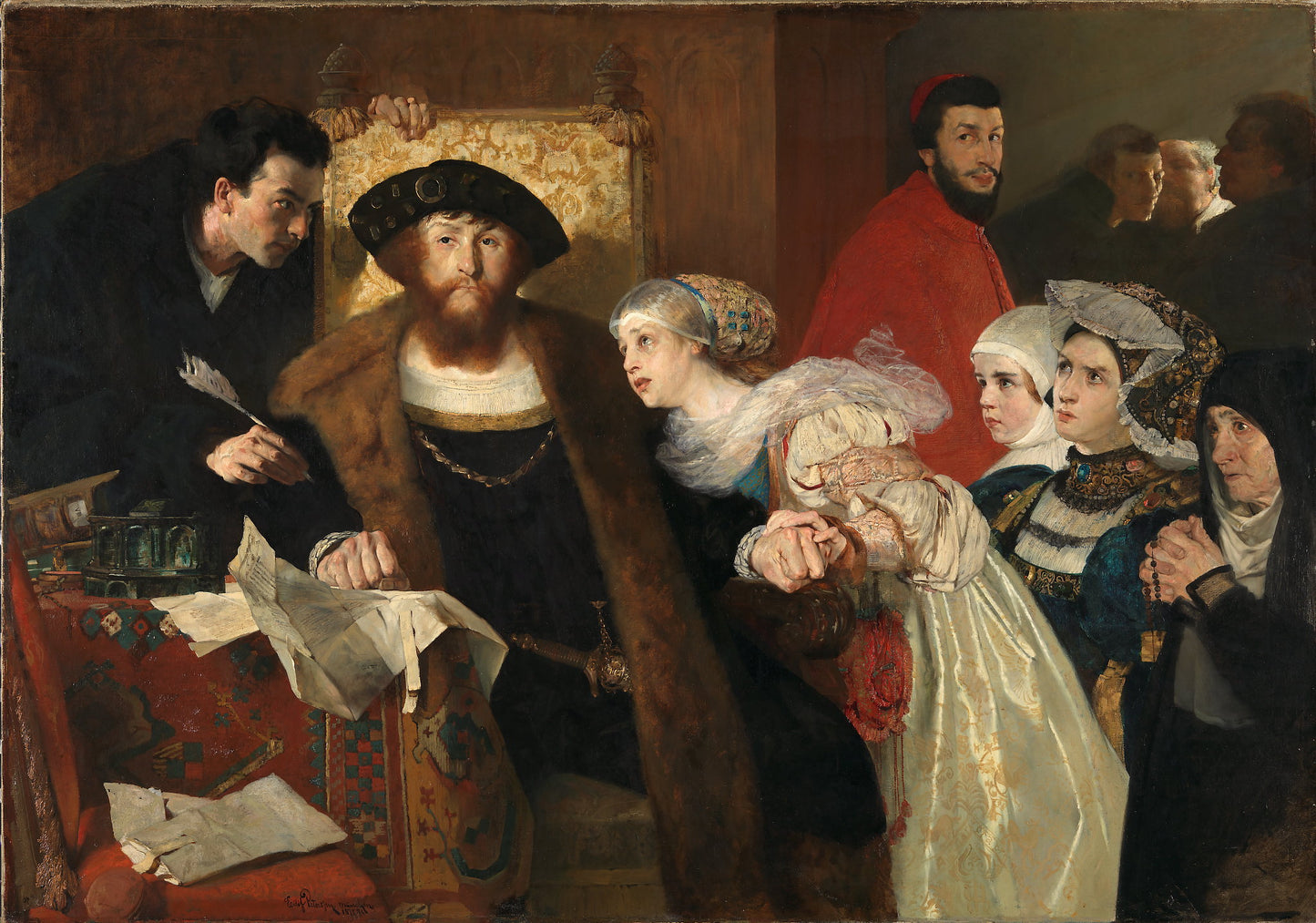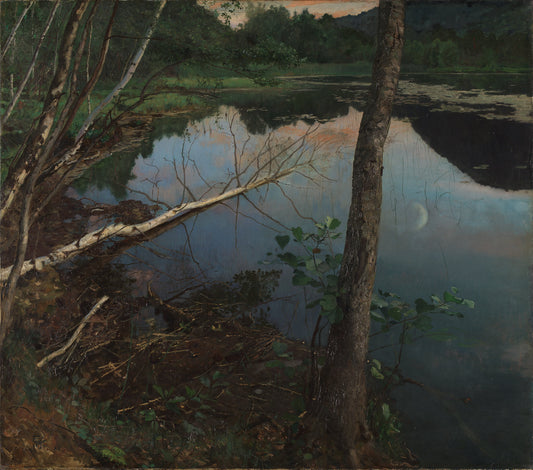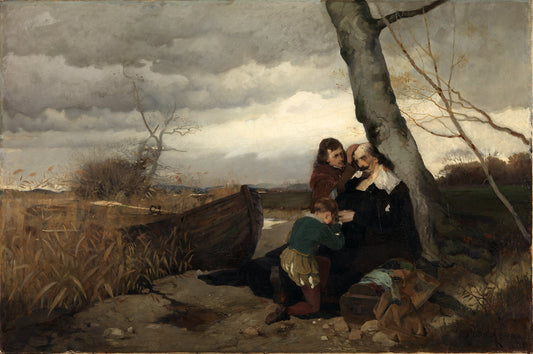Eilif Peterssen
Christian II signs the death sentence on Torben Oxe
Christian II signs the death sentence on Torben Oxe
Couldn't load pickup availability
About the original:
The scene shows the psychologically dramatic moment when the king, clearly in doubt, considers whether or not to carry out the sentence. Next to him is the advisor Didrik Slagheck, who hands him the quill for him to sign the document. On the opposite side stands Queen Isabella, looking at him with tearful eyes, clearly with a desire to avert the action. Both lean towards the king – he in black, she in white, as symbols of the battle of good against evil.
The image space is shallow and filled with figures. In addition to the three main characters in the unfolding drama, a total of seven people are crowded together in the right half of the picture, with the red-clad cardinal as an eye-catcher and perspective-creating tool. Stylistically, the picture shows that Eilif Peterssen was at this time clearly influenced by the Munich school and studies of Venetian Renaissance painting. This becomes apparent in the wealth of detail, the materiality, the color scheme with an emphasis on warm tones, and in the contrasts between light and dark parts. Thorough preparations were made for the painting, with studies of historical source material and previous representations of the king.
Peterssen mastered several genres. In addition to history paintings, he painted both landscapes and genre scenes. He was also an outstanding portrait painter.
Text: Marianne Yvenes
From "Highlights. Art from Antiquity to 1945", The National Museum 2014, ISBN 978-82-8154-084-2
Date: 1875–1876
Other titles: Christian II signing the Death Warrant of Torben Oxe (ENG)
Designation: Painting
Material and technique: Oil on canvas
Technique: Oil
Material: Canvas
Dimensions: 141.5 x 200.5 cm
Subject: Visual arts
Classification: 532 - Visual arts
Motif: Historical scene or person
Acquisition: Purchased with a contribution from the Norwegian Culture Fund 1977
Inventory no.: NG.M.03118
Part of exhibition: Art 3. Works from the collection 1814-1950, 2007 - 2011
The dance of life. The collection from antiquity to 1950, 2011 - 2019
Registration level: Single object
Owner and collection: The National Museum of Art, Architecture and Design, Visual Art Collections
Photo: Høstland, Børre/Lathion, Jacques
High-quality reproductions from the National Museum's collection. Posters by DAIDDA are printed on Litho White Matt - 230 gram photo paper in premium quality. Artprints by DAIDDA provide outstanding colors, sharpness and durability in museum quality - printed on Moab Entrada Natural 300 gram cotton art paper. Printed on a matte surface with scratch-resistant pigment ink.
Shipping and returns
Shipping and returns
Shipping: We deliver to Scandinavia, the EU, the USA and several other countries. Please contact us if your country is not listed and we will try to arrange delivery.
Delivery time: 2-5 days within Norway, 7 days in Europe, 14 days globally.
Packaging: Our products are made to order and sent rolled in environmentally friendly packaging.
Customs Fees: International orders may be subject to customs fees, which are not included in shipping costs.
Return policy: You can return images within 14 days. See our returns page for more information.
Secure Payment: We never store your payment details. See our privacy policy for details.

See all works
-
Summer night
Vendor:Eilif PeterssenRegular price From 150,00 NOKRegular priceUnit price per -
The painter Kitty L. Kielland
Vendor:Eilif PeterssenRegular price From 150,00 NOKRegular priceUnit price per -
Death of Corfitz Ulfeldt
Vendor:Eilif PeterssenRegular price From 150,00 NOKRegular priceUnit price per

Eilif Petersen
Eilif Peterssen was a Norwegian painter who had a central position in Norwegian contemporary art. He was the first of his generation to be represented in the National Gallery. Peterssen was a pupil of Johan F. Eckersberg in 1869–1870 and studied at the Academy of Fine Arts in Copenhagen in 1871, Karlsruhe in 1871–1873 and Munich under Wilhelm Diez in 1873–1875.
Peterssen received strong impressions of older art during his studies in Munich and Venice in 1875. He is known for his historical compositions such as "Death of Corfitz Ulfeldt" (1873–1874), "Christian 2 signs Torben Oxe's death warrant" (1875–1876) and "Judas Ischariot" (1878), as well as several excellent portraits of famous people such as Hans Heyerdahl, Henrik Ibsen, Johan Svendsen, and Harriet Backer. In 1878 he left Munich and stayed in Italy in the period 1879–1883, where he quickly developed into a plein air painter. He painted works such as "Siesta in an osteria in Sora" (1880) and "Piazza Montanara" (1883). Peterssen also painted his most significant altarpiece, "The Adoration of the Shepherds", which hangs in Jakob Church in Oslo (1881).
Later in his career, Peterssen cultivated the Nordic atmospheric landscape and painted, among other things, "Sommernatt" (1886) and "Nocturne" (1887) while he was at Fleskum in Bærum together with Norwegian painters. He also painted several portraits, including "Kalle Løchen" (1885), "Alexander Kielland" (1887), "Mor Utne" (1888), "Edvard Grieg" (1891) and "Arne Garborg" (1894). Peterssen was caught up in the atmospheric and style-seeking tendencies of neo-romanticism, but after 1890 his art showed a clear decline in quality. His last major works were the decorative series "Gujamar's song" (1904–1907) and "Himmelfarten" in Ullern church's apse (1908–1909). Peterssen also designed the Norwegian coat of arms in 1905.





